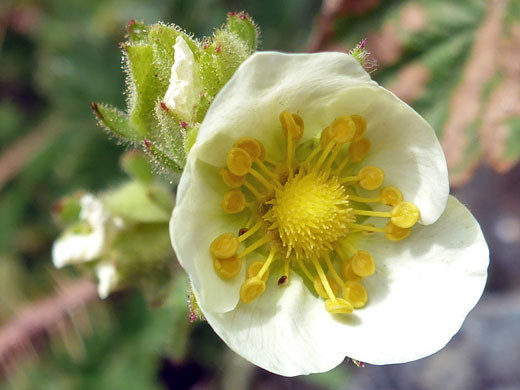
Round white petals and pale green sepals - drymocallis convallaria along the Titcomb Basin Trail, Wind River Range, Wyoming
Common name:
Cream cinquefoil
Family:
Scientific name:
Drymocallis convallaria
Main flower color:
Range:
The Rocky Mountain states, and all states to the west, except California
Height:
Up to 3 feet
Habitat:
Meadows, open woodland, grassy hillsides; from near sea level to 10,000 feet
Leaves:
Compound, up to 10 inches long, with up to 9 doubly toothed leaflets
Season:
June to August
Leaves of drymocallis convallaria are divided into a terminal leaflet and well separated pairs of side leaflets; those at the base usually have three or four pairs, while stem leaves have exactly three. The terminal leaflet is obovate in shape. Leaves are dark green above, lighter green below, and they have a sparse covering of very short hairs. Leaflets are lined by large teeth, each terminating in a tiny red spike. Stems have a dense covering of hairs, supporting spherical glands.
Stems are topped by an open cluster of up to 40 flowers, held above the leaves. Flower stalks are up to one inch long, and glandular hairy, as are the five green sepals, often red-tipped. Flowers tend to open widely, with petals and sepals held at around 90 degrees to the stem; the white or pale yellow petals are non-overlapping, ovate to obovate in shape, sometimes shallowly notched at the tip. Sepals and petals are approximately equal in length; up to 0.3 inches. The yellow stamens have thin filaments and rounded anthers, and are arranged around a dome of tiny green to yellow carpels.
Stems are topped by an open cluster of up to 40 flowers, held above the leaves. Flower stalks are up to one inch long, and glandular hairy, as are the five green sepals, often red-tipped. Flowers tend to open widely, with petals and sepals held at around 90 degrees to the stem; the white or pale yellow petals are non-overlapping, ovate to obovate in shape, sometimes shallowly notched at the tip. Sepals and petals are approximately equal in length; up to 0.3 inches. The yellow stamens have thin filaments and rounded anthers, and are arranged around a dome of tiny green to yellow carpels.
All Contents © Copyright The American Southwest | Comments and Questions | Contribute | Site Map


